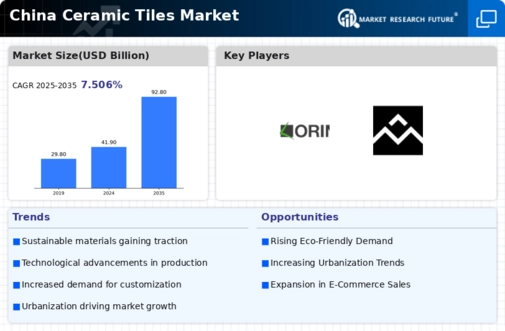Rising Urbanization
The rapid urbanization in China is a pivotal driver for the ceramic tiles market. As urban areas expand, the demand for residential and commercial properties increases, leading to a heightened need for flooring solutions. In 2025, urbanization rates in China are projected to reach approximately 65%, which translates to millions of new housing units requiring ceramic tiles. This trend is further supported by government initiatives aimed at improving urban infrastructure, which often includes the installation of durable and aesthetically pleasing ceramic tiles. The ceramic tiles market is likely to benefit from this urban growth, as consumers seek high-quality materials that can withstand the rigors of urban living while also enhancing the visual appeal of their spaces.
Increasing Disposable Income
The rise in disposable income among the Chinese population is significantly influencing the ceramic tiles market. As consumers experience greater financial freedom, they are more inclined to invest in home improvement and renovation projects. Reports indicate that the average disposable income in urban areas has increased by over 10% annually, leading to a surge in demand for premium ceramic tiles. This trend is particularly evident in metropolitan regions where consumers prioritize quality and design in their home interiors. The ceramic tiles market is poised to capitalize on this growing consumer spending, as individuals seek to create stylish and comfortable living environments that reflect their personal tastes.
Shifts in Consumer Preferences
Consumer preferences in China are evolving, with a noticeable shift towards modern and stylish interior designs. This change is driving the ceramic tiles market as homeowners and designers increasingly opt for unique patterns, textures, and colors. The demand for customized and designer ceramic tiles has surged, reflecting a broader trend towards personalization in home decor. In 2025, it is anticipated that the market for decorative ceramic tiles will grow by approximately 15%, as consumers seek to differentiate their spaces. The ceramic tiles market is adapting to these preferences by offering innovative designs and sustainable options, catering to the desires of a more discerning clientele.
Government Infrastructure Projects
Government-led infrastructure projects in China are a crucial driver for the ceramic tiles market. The Chinese government has committed substantial funding towards urban development, including the construction of public facilities, transportation hubs, and commercial spaces. In 2025, it is estimated that infrastructure spending will exceed $1 trillion, creating a robust demand for ceramic tiles in various applications. These projects often require durable and visually appealing materials, making ceramic tiles a preferred choice. The ceramic tiles market stands to gain significantly from these initiatives, as they not only boost demand but also enhance the overall quality of urban environments.
Technological Innovations in Production
Technological advancements in the production of ceramic tiles are reshaping the market landscape in China. Innovations such as digital printing and advanced glazing techniques are enabling manufacturers to produce high-quality tiles with intricate designs and improved durability. These technologies not only enhance the aesthetic appeal of ceramic tiles but also reduce production costs and waste. In 2025, it is expected that the adoption of these technologies will increase by 20%, allowing manufacturers to meet the growing demand for both standard and customized products. The ceramic tiles market is likely to benefit from these advancements, as they provide a competitive edge in a rapidly evolving marketplace.













Leave a Comment